Posted by Anita on 07.26.09 11:30 PM
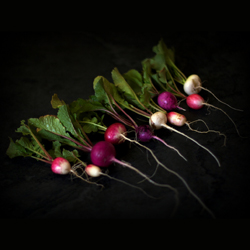 This week, we had so much going on that we lost track of our One Local Summer meal entirely. It’s not that we didn’t enjoy lots of fresh, fabulous treats from the market and our garden, we just weren’t diligent about documenting any of them. Many dinners were repeats of past OLS post, or just the kind of no-recipe suppers thrown together on a summer evening.
This week, we had so much going on that we lost track of our One Local Summer meal entirely. It’s not that we didn’t enjoy lots of fresh, fabulous treats from the market and our garden, we just weren’t diligent about documenting any of them. Many dinners were repeats of past OLS post, or just the kind of no-recipe suppers thrown together on a summer evening.
We’d planned to make up for lost time at the end of the week, but other things came up — a touch of a sore throat, followed by a last-minute weekend trip — and we found ourselves empty-handed for this week’s roundup.
Luckily, we had something we’ve kept in our back pocket in case of just such an eventuality. We first tossed this simple salad together back at the end of May, just as we were reaching the end of our first shelling pea crop. The plants had begun to die off, and we were ready to turn them back into the soil and plant another crop. But there were just enough peas left for one last splurge.
And actually, it’s the perfect salad to enjoy at the beginning of a pea harvest, too — a place we find ourselves this week, with our second pea crop — or any other time you’ve got a mixture of mature peas, immature pods, and a few small tendrils. If you’re a cleverer gardener than we are, and you’ve mastered the art of successive plantings, you can even use the thinnings from your next batch of peas, too.
But even if you buy every last stitch from the farmers market, you’ll be rewarded with a light, fragrant salad, equal parts crisp and creamy.

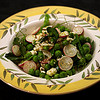

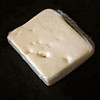

Pea and Radish Salad with Feta
– loosely adapted from Bon Appetit
1 tsp cumin seeds
1 T fresh lemon juice
1/2 tsp honey
2 T extra-virgin olive oil
3 springs fresh thyme, leave stripped
1-1/2 cups fresh shelled peas
6-10 snow peas (or immature homegrown peas), julienned
5-7 medium radishes, thinly sliced
1/2 cup crumbled feta cheese (about 2 oz)
1-1/2 cups pea sprouts or very tender pea tendrils
Toast the cumin seeds in a small skillet over medium heat until aromatic, about 2 minutes. Cool the seeds, then grind in a spice mill or coffee grinder. In a small bowl, whisk together the dressing ingredients (cumin to thyme); season to taste with salt and pepper, keeping in mind that feta can be quite salty.
Blanch the peas in boiling salted water until just tender, about 3 minutes. (Timing will vary based on freshness, age, and size of peas.) Scoop peas out of the pan and into an ice-water bath. Repeat blanching with the snow-pea strips; this will take about 1-2 minutes.
Drain peas and snow pea strips very well. Combine them in a medium bowl with the sliced radishes and crumbled feta. Drizzle with about half the dressing and toss. Taste and add more dressing, salt, and pepper as needed.
Divide pea sprouts or tendrils among 2 or 3 wide salad bowls, and top with the dressed salad. Serve at once.
Farmers and food artisans who created the ingredients for this week’s recipe:
Marshall’s Farms, American Canyon: Honey
Bariani, Sacramento: Olive oil
Spring Hill Cheese Company, Petaluma: Goat feta
…and our own homegrown lemons, thyme, peas, and radishes
locavore, One Local Summer, recipes
5 Comments »




Posted by Anita on 07.19.09 10:22 PM
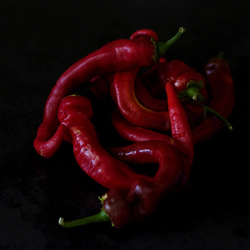 At this time of year, when the garden’s finally kicking into high gear, and all of our favorite foods are in plentiful supply at the farmers market, I rarely pick up a cookbook, and hardly even use recipes.
At this time of year, when the garden’s finally kicking into high gear, and all of our favorite foods are in plentiful supply at the farmers market, I rarely pick up a cookbook, and hardly even use recipes.
The vast majority of our summer meals follow a dead-easy formula: A little bit of meat, usually rubbed or marinated and then seared on the grill; an unfussy starch, finished with a knob of fresh butter or a drizzle of olive oil; and big helping of vegetables, either in the form of a chopped salad or a simple saute. Usually, there’s fruit for dessert — maybe paired with ice cream or cookies, if we’re feeling fancy.
The few recipes that find their way out of the files are usually tried-and-true favorites, and this one is no exception. We’ve been making this succotash for nearly three summers now — it first appeared on the blog as a passing reference back in 2006 — and it feels like an old friend. We’re finally seeing peppers in the market, so we hauled it out for the first time this summer, and enjoyed it as the centerpiece of this week’s One Local Summer meal, alongside a grilled tri-tip with a Santa Maria-style rub (equal parts salt, pepper, and garlic granules, moistened with olive oil).
We’ve made some changes to the succotash recipe along the way, swapping out the original’s summer squash (which neither of us really likes) in favor of other summery flavors like green garbanzos or late-season peas. But no matter how many tweaks we make, it remains one of those tastes of summer that we anticipate all year long.
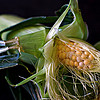

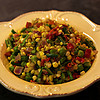

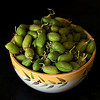
Summer Succotash
– adapted from Bon Appetit
1T extra-virgin olive oil
1 cup chopped onion
1 cup diced sweet red pepper
1-1/2 tsp fresh thyme leaves
2 garlic cloves, minced
4 ounces slender green beans, trimmed, cut into 3/4-inch pieces (~1 cup)
1/2 cup green garbanzos (or substitute mature favas or starchy peas)
1 cup fresh corn kernels (cut from 2 ears of corn)
2T cream
Heat oil in large skillet over medium-high heat. Add onion; reduce heat to medium and saute until beginning to soften, 2 to 3 minutes. Add pepper, thyme, and garlic; saute 1 minute. Add garbanzos and 1/4 cup of water; cover and cook until the garbanzos are just beginning to soften, 4 to 6 minutes longer. Add the green beans and saute until all vegetables are crisp-tender, about 4 minutes more. Stir in corn and cream, and saute until just heated through. Remove from heat, season with salt and pepper, and serve immediately.
Farmers and food artisans who created the ingredients for this week’s meal: Bariani
Bariani, Sacramento: Olive oil
Everything Under the Sun, Winters: Red onions
The Peach Farm, Esparto: Red frying peppers
Hunter Orchards, Grenada: Garlic
Catalán Family Farm, Hollister: Green garbanzos
Pinnacle/Phil Foster Ranch, Hollister: Corn
Claravale Farm, Paicines: Raw Jersey cream
…and our own homegrown thyme and green beans
locavore, One Local Summer, recipes
6 Comments »




Posted by Anita on 07.14.09 12:33 PM
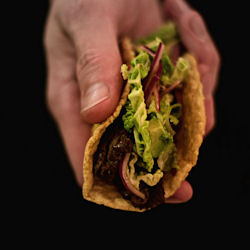 One day a couple of weeks ago, I decided to make a batch of homemade kimchi using an extra head of cabbage I had knocking around. Of course, this simple use-it-up kitchen project required a trip across town to a Korean grocery store for the requisite red-pepper seasoning mixture, but I’ve got an anti-food-waste streak a mile wide.
One day a couple of weeks ago, I decided to make a batch of homemade kimchi using an extra head of cabbage I had knocking around. Of course, this simple use-it-up kitchen project required a trip across town to a Korean grocery store for the requisite red-pepper seasoning mixture, but I’ve got an anti-food-waste streak a mile wide.
In a bit of kitchen synchronicity, I’d been meaning to make our friend Matthew‘s recipe for Korean tacos — a recent trip to L.A. left us with a hankering for this hipster street chow but unable to stomach Kogi‘s ridiculous 3-hour lines — and kimchi seemed like a natural accompaniment.
Last weekend at the farmers market, our list was very short. Knowing we were heading off to New Orleans last Wednesday, we really only needed to make one dinner at home. Could we combine our Korean supper with our One Local Summer meal? Turns out, the recipe doesn’t require any exotic ingredients, and by stretching our challenge’s seasoning exemptions to include soy sauce and a small amount of sesame oil, we were able to source everything we need from within our 100-mile radius.
Of course, the best-laid plans often lead to disappointment, and my first batch of kimchi never really got the hang of fermentation. I tried again a few days later using a different recipe, and although it seemed headed in the right direction, the cabbage never released enough liquid, and the result was dry and funky.
But although I still haven’t found a kimchi recipe that works for me, that didn’t stop me from including it in our locavore feast. Turns out, there’s a locally made brand — King’s — that all the nearby Asian markets sell. It’s spicy and fresh-tasting, even if it’s not as beautiful or as romantic as the homemade sort.
This recipe also gave us a chance to try out the meat slicer we bought a few weeks ago. If you don’t have a fancy gizmo like ours, you may be able to ask your butcher to shave the meat for you. Or, you can freeze it briefly (although not until it’s completely solid) and use a very sharp knife to cut pieces as thin as possible.
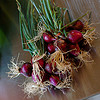
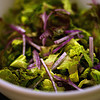

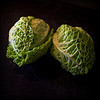
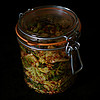
Korean Rib-Eye Tacos
– adapted from Matthew Amster-Burton
3/4 pounds rib eye, sliced paper thin
1T soy sauce
1 to 2T sugar
1T minced garlic
2 tsp Asian sesame oil
1 tsp sherry or mirin
1 tsp water
—
1-1/2 tsp soy sauce
3/4 tsp lime juice
3/4 tsp toasted sesame oil
2 cups shredded romaine lettuce
1 cup shredded Napa cabbage
1/4 cup thinly sliced red onion
toasted sesame seeds
—
chopped avocado
kimchi, Korean red pepper flakes, or fermented chili paste
corn tortillas (6 to 10, depending on size)
Combine the meat with the rest of the marinade ingredients, and refrigerate for between 2 and 24 hours. Bring meat to room temperature, then cook under a broiler or in a well-heated skillet. If needed, chop into smaller, taco-friendly pieces.
Whisk together the soy sauce, lime juice, and toasted sesame oil. Toss the lettuce, cabbage, and red onion in a large bowl with half of the dressing. Add more dressing to taste, then garnish generously with sesame seeds.
Warm the tortillas over a gas burner or in a dry skillet. Top with meat, slaw, avocado, and your choice of spicy condiments.
Farmers and food artisans who created the ingredients for this week’s meal: Marin Sun Farms
Marin Sun Farms, Point Reyes: Grass-fed pastured rib-eye steak
Hunter Orchards, Grenada: Garlic
Paradez Farms, Exeter: Limes
Marin Roots Farm, Petaluma: Romaine
Dirty Girl Produce, Santa Cruz: Cabbage
Mariquita Farm, Watsonville: Red onions
Will’s Avocados, Soledad: Avocados
Primavera, Sonoma: Corn tortillas
King’s Asian Gourmet, San Francisco: Kimchi
locavore, meat, One Local Summer, recipes
8 Comments »




Posted by Cameron on 07.10.09 9:08 AM

Originally posted on the Tales Blog, where we’re working with many other cocktail bloggers to cover Tales of the Cocktail, 2009.
As someone who has been to my share of trade shows and conferences, I can tell you that the phrase “convention lunch†is enough to strike fear into the heart of the boldest traveler. But this is Tales of the Cocktail, which is about as un-convention-al as it gets. You can count on a good time in the seminars, tasting rooms, and party rooms, and then stroll out to some seriously good food.
Yesterday was the perfect example. We rolled out of bed, still on Pacific Time and fuzzy from the previous night’s festivities, cleaned up a bit, and then hit the bricks, aiming for the river, Cafe du Monde, and beignets with cafe au lait. The beignets come three to a plate, snuggled into a pile of powdered sugar that looks like nothing so much as the scene in the third act of Scarface where Tony Montana plunges his face into a mountain of cocaine. Instead of our noses, we plunged our beignets into the fluffy white mound while a singing, trumpet-playing entertainer performed “Down by The Riverside,†“Danny Boy,†and other feats of musical daring for the amusement of passers-by.
On our way back to the hotel, our eyeballs vibrating ever so slightly from the sugar buzz, we realized that our “lunch†break wouldn’t come until 2:30, and that we needed something a bit more substantial to carry us through the day. So, we stopped at Johnny’s Po-Boys and split an egg and bacon po’boy, washed down with a couple of Barq’s root beer sodas. Mother’s may get more attention, but for our money, Johnny’s is the spot. It’s a place of wonderful mysteries. How do they manage to get the rolls to be tender, chewy, and flaky all at the same time? How can they offer fried chicken with a homemade biscuit and white gravy for $2.50 a plate? And how am I going to manage to get here enough times this week, given all the other great places that we’ll be eating at?
Back at Tales, we soaked up some knowledge and tasted some spirits, but I have to admit that I was already looking forward to our next food foray. We roped in Marshall from Scofflaw’s Den and headed back into the Quarter, aiming for Central Grocery and its famous muffuletas.
I had my first Central Grocery muffuletta at last year’s Tales, and it was a madhouse. There was a line out the door, and every horizontal surface was staked out by someone eagerly devouring one of the sandwiches. Today, there were no crowds, which made the lunchtime experience much more civilized. But even if it were wall-to-wall people, it wouldn’t have mattered. If there’s anything wrong with loving a sandwich the size and shape of a hubcap, spread with oily, tangy olive salad and filled with all sorts of good things (salami, capicola, and provolone, just to name a few), I don’t want to be right.
The best part? The day wasn’t over, much less the week. We have got to get to Green Goddess, and there’s a slew of other stuff on the schedule. And no matter where we are I’m pretty sure that there’s another plate of beignets calling my name, down by the riverside.





New Orleans, restaurants, Tales of the Cocktail
6 Comments »




Posted by Anita on 07.05.09 11:03 PM
 When I first read the recipe that served as the inspiration for this week’s One Local Summer supper in the September 2006 issue of Bon Appetit, I knew we would have to make it. The official name of the dish was the prosaic “Spanish Pork Braise”, but the real hook was rendered in 48-point type over a stunning photo of braised pork shanks and sunny garbanzo beans: “PORK x4”. Really, have you ever heard of a happier notion? Not just pork — pork four times over!
When I first read the recipe that served as the inspiration for this week’s One Local Summer supper in the September 2006 issue of Bon Appetit, I knew we would have to make it. The official name of the dish was the prosaic “Spanish Pork Braise”, but the real hook was rendered in 48-point type over a stunning photo of braised pork shanks and sunny garbanzo beans: “PORK x4”. Really, have you ever heard of a happier notion? Not just pork — pork four times over!
Of course, with September being the height of San Francisco’s Indian summer, the idea of a hearty braise heating up the house wasn’t really appealing at the time. But I knew, some foggy summer day in the future, I’d have the perfect recipe at hand.
Finding osso-bucco–style pork-shank pieces at the farmers market isn’t really an everyday occurrence (although Marin Sun Farms will do them by special order), so I never found myself hunting down the recipe. But then, last week, while browsing through my recipe file looking for a way to use up some porky odds and ends in the freezer, I rediscovered this captivating clipping. The pork shank I had on hand was whole — we’d brought it home from our pig-butchering class — but a braise is a braise is a braise. Even if pulled meat doesn’t look quite as nice as a neatly tied shank steak, it still tasted delicious.
The original recipe is served with a side of garbanzo beans dressed up with a sprinkling of gremolata. We were lucky enough to pick up fresh, green garbanzos at the market last week, and substituted them for canned, after a quick pan-poaching. If you’re wondering what to do with the starchy late peas you’re finding at the market, I suspect they’d made a great alternative, too.

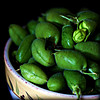
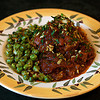

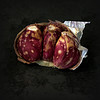
Pork Times Four
– adapted from Steve Johnson’s Spanish Pork Braise, Bon Appetit
4 to 5 pounds bone-in pork for braising
(such as a whole pork shank, or 6 x 2-1/2-inch thick shank pieces, or a meaty soup bone plus large chunks of shoulder meat)
1/2 pig’s foot
1 to 2 links Spanish-style chorizo, sliced
2 T extra-virgin olive oil
2 large carrots, medium dice
1 large onion, medium dice
6 large garlic cloves, smashed
1/2 T chopped fresh savory (or 1T chopped thyme)
1 cup medium-dry Sherry
1 28-ounce can plum tomatoes in juice, tomatoes coarsely chopped
2 cups pork (or chicken) stock
3 dried ancho chiles, halved, stemmed, seeded
2 T tomato paste
1-1/2 tsp ground cumin
1 tsp ground coriander
—
2T olive oil
3 cups cooked garbanzo beans
1 large clove of garlic, minced
large pinch of saffron
1/4 cup chopped parsley
2 thin slices proscuitto or ham, minced
1/2 cup chopped toasted almonds
1T grated citrus peel, preferrably orange
Preheat the oven to 350°F. Sprinkle pork and pig’s foot with salt and pepper. Heat a wide Dutch oven over medium heat, and add the chorizo slices. Saute the chorizo, adjusting heat as needed to render the fat and brown the meat. Remove the browned chorizo to a plate using tongs or a slotted spoon. Increase heat to medium-high, and saute the pork until brown, turning to caramelize all sides. (Depending on the size of your pan, you may need to work in batches. If your chorizo is particularly lean, you may need to add some additional oil.) Remove browned pieces to a plate or baking sheet, and reduce heat to medium low.
Add carrots, onion, garlic, and herbs to the pan, and cook until onion softens, about 4 to 6 minutes. Add the sherry to the pan, and deglaze. Add the tomatoes and their liquid, stock, chiles, cumin, and coriander. Bring to a boil, and return browned meat, chorizo, and pig’s foot to the pan. Return to a boil, then cover and place in the preheated oven. Braise until the meat is tender and just pulling away from the bone, 90 minutes to 3 hours.
When meat is cooked through, de-fat the sauce with a spoon. (Alternately, you can cool the mixture and refrigerate overnight; the fat will solidify and be easily removed the next day.) If the sauce remains chunky, you may want to remove the meat and puree it with a stick blender; if so, take care to leave some texture.
Heat oil in a skillet over medium-low heat. Add beans, garlic, and saffron, and saute until heated through. Mix in the proscuitto, and season to taste with salt and pepper.
Mix together parsley, almonds, and zest in a small bowl.
To serve, place equal amounts of pork on 6 plates, spooning sauce around. Serve garbanzos on the side, and sprinkle the whole plate with gremolata, reserving some to pass at the table.
Farmers and food artisans who created the ingredients for this week’s meal: Devil’s Gulch Ranch
Devil’s Gulch Ranch, Nicasio: Pork shank & picnic meat
Marin Sun Farms, Point Reyes: pig foot
Fatted Calf, Napa: Chorizo
Bariani, Sacramento: Olive oil
Mariquita Farm, Watsonville: Onion, savory
Hunter Orchards, Grenada: Garlic
Tierra Vegatables, Santa Rosa: Ancho chiles & carrots
Short Night Farm, Dunnigan: Green garbanzo beans
Boccalone, Oakland: Proscuitto
Star Route, Bolinas: Parsley
Alfieri Farms, Esaclon: Almonds
Paradez Farms, Exeter: Blood orange…plus our own home-canned tomatoes & paste (from Mariquita’s tomatoes), homemade pork stock, and homegrown coriander.
locavore, meat, One Local Summer, recipes
2 Comments »




 This week, we had so much going on that we lost track of our One Local Summer meal entirely. It’s not that we didn’t enjoy lots of fresh, fabulous treats from the market and our garden, we just weren’t diligent about documenting any of them. Many dinners were repeats of past OLS post, or just the kind of no-recipe suppers thrown together on a summer evening.
This week, we had so much going on that we lost track of our One Local Summer meal entirely. It’s not that we didn’t enjoy lots of fresh, fabulous treats from the market and our garden, we just weren’t diligent about documenting any of them. Many dinners were repeats of past OLS post, or just the kind of no-recipe suppers thrown together on a summer evening.
































